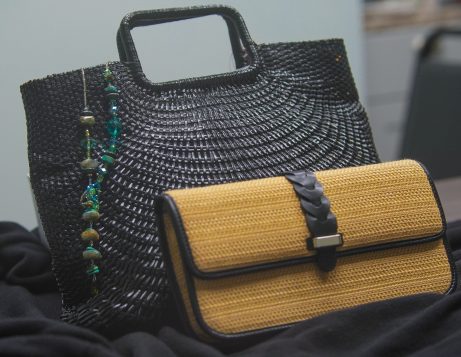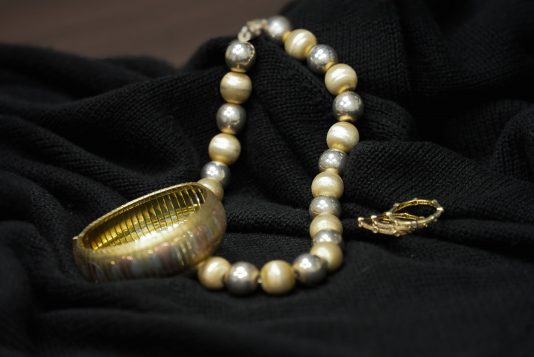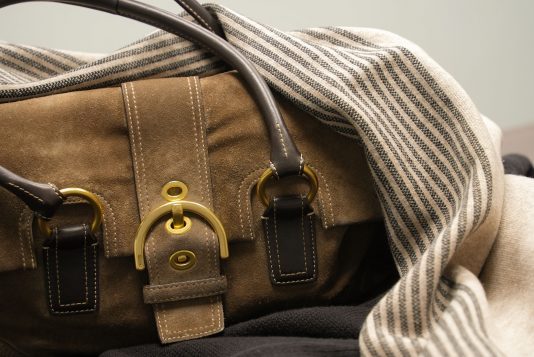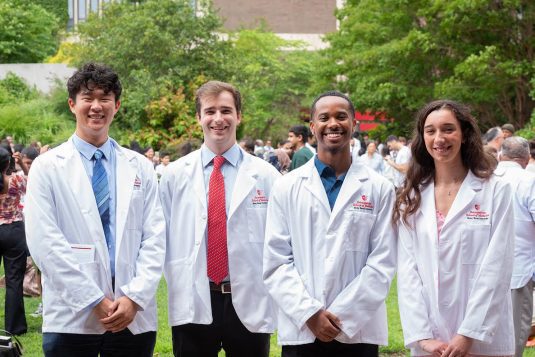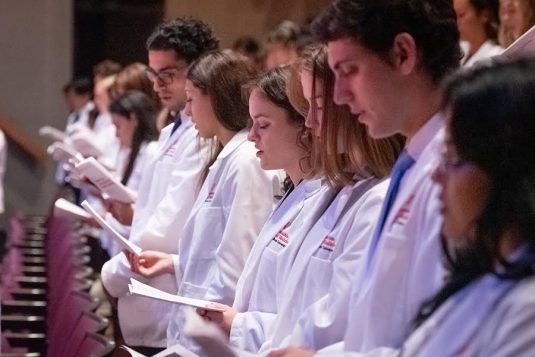Physicist Mary Bishai of the U.S. Department of Energy’s (DOE) Brookhaven National Laboratory has been named a 2024 DOE Office of Science Distinguished Scientist Fellow. The honor recognizes her “enduring contributions at the intensity frontier of high energy physics in unraveling fundamental properties of neutrinos, extraordinary leadership and service to the particle physics community, and deep commitment to broadening participation through mentoring next generation scientists.”
As described in a DOE Office of Science press release issued on Aug. 13, the Distinguished Scientist Fellows program was established to develop, sustain, and promote scientific and academic excellence in Office of Science research through collaborations between universities and national laboratories. Bishai, one of four scientists being honored this year, will receive the award — which consists of $1 million in direct funding for her research — at a ceremony on January 14, 2025, where she will also deliver an online lecture and field questions about her career [registration link: https://science-doe.zoomgov.com/webinar/register/WN_p3QlS3XkRrS9leRYcscytw#/registration].
“It is an honor to recognize the outstanding research of these awardees,” said Harriet Kung, acting director of the DOE Office of Science. “They are advancing science solutions for the nation and taking on some of our biggest challenges in bioenergy, materials science, physics, and computing. I look forward to their continued success and impactful results, especially as they continue to move forward in their careers, inspiring a new generation of scientists ready to tackle the big questions and challenges of the future.”
Bishai has made understanding the properties of elementary particles her life’s work, and she has spent the last two decades at Brookhaven working to understand the properties of the elusive neutrino . Her leadership on neutrino experiments led her to be elected co-spokesperson of the Deep Underground Neutrino Experiment (DUNE) in January 2023. DUNE is a 1,400-person project with scientists from more than 30 countries and 200 institutions. This experiment will shoot neutrinos over a thousand kilometers from DOE’s Fermi National Accelerator Laboratory (Fermilab) in Illinois through Earth’s crust to detectors deep within the Sanford Underground Research Facility(SURF) in South Dakota to see how these enigmatic entities change as they travel.
“This fellowship is a great honor,” she said. After spending her early career working at Purdue University and studying charm quarks at the CLEO experiment at Cornell University, Bishai transitioned to work at DOE laboratories. She reflected, “I have spent a rewarding career involved in leading particle physics experiments at the national labs, including 20 years at Brookhaven.”
Bishai is excited for DUNE’s possible insight into several fundamental questions in physics. Chief among those is why our universe is made of matter, or as she put it, “why we are here.” DUNE will allow scientists to look for differences between how neutrinos and their antimatter opposites, antineutrinos, behave. Finding a difference could help explain why the early universe — which should have contained the two in equal, mutually annihilating amounts — somehow favored the existence and persistence of matter. Observations by terrestrial detectors like DUNE of the energy and time distributions of neutrinos emitted by the Sun or during the explosion of a nearby supernova will also provide a clearer picture of how stars work.
Bishai’s outlook and enthusiasm extend beyond the science to the scientists themselves. “The most fun of all,” she said, has been guiding the next generation of researchers. “As a mentor, I am making sure that my students are integrated, making sure they understand what they’re doing, and I’m trying to talk about careers a lot,” she shared.
Detection detective
Brookhaven scientists have been at the forefront of neutrino research for decades, developing complex detector technologies, including giant liquid argon-filled detectors and the cold microelectronics that read out their signals. Bishai’s work builds on that legacy.
“Brookhaven is where the first successful neutrino beam from an accelerator was produced as part of a Nobel Prize-winning experiment that established that neutrinos have ‘flavors,’ or different types. This was followed by Ray Davis’ groundbreaking Nobel Prize-winning experiment to detect solar neutrinos using a massive detector underground in the former Homestake Gold Mine in South Dakota. That experiment produced the first hint that neutrinos oscillate, or change, between different flavors. DUNE is the latest generation, using accelerator-produced neutrinos to further study neutrino flavor oscillations to learn more about our universe,” Bishai said.
Part of the challenge with all these experiments is that neutrinos have extraordinarily little mass, no charge at all, and interact with matter only rarely. So how exactly do scientists measure a chargeless particle that can fly through walls with ease while shapeshifting among three known flavors? The key is in detecting “fingerprints” neutrinos leave in the argon bath.
As in many of the earlier experiments, DUNE’s detectors will be deep underground to filter out other types of particle interactions. When incoming neutrinos enter the chilly, 87 Kelvin (-303 degrees Fahrenheit) pool of liquid argon, they’ll very occasionally interact with one of the argon atoms. Those interactions kick various charged particles out of the argon nuclei. Next, the charged particles set off a cascade of ionization, knocking electrons off more atoms in the argon bath. The interactions of the initial neutrino and the secondary charged particles with argon also generate flashes of light.
Scientists match the flashes of light, which travel almost instantaneously through the detector, with the later arrival of electrons freed by ionization as they strike electrodes on the sides of the detector.
“Because you know how fast it takes for the charge to go, and you know when the interaction happened from the flash of light, you can figure out exactly where the interaction took place inside the detector, and you can use computers to reconstruct the tracks,” Bishai said.
Then, it’s about fitting the puzzle pieces together. Since each neutrino produces different types of tracks, these tracks can be analyzed to pinpoint the flavor of the neutrino that created each track.
Keeping it inclusive — for data and people
Bishai has been recognized for being a relentless champion for the science of neutrinos and the scientific program of the DUNE experiment, starting from her role as project scientist when the DUNE collaboration was first formed in 2015 and subsequently as a leader of various physics working groups in the collaboration.
Throughout her career, and as DUNE co-spokesperson, she has worked consistently to bring others into the field.
As an example, she has mentored more than 20 young scientists, mostly through the DOE-funded Science Undergraduate Laboratory Internship program at Brookhaven Lab and students who visited Brookhaven while participating in the African School of Physics. Bishai recalled how she worked with students to test hundreds of DUNE’s cold microelectronic chips by dipping them in liquid nitrogen that’s nearly as cold as the liquid argon will be.
“I learn more when I teach because I have to dig deep into the science myself, dig deep into the technical issues, to be able to then translate it into simpler concepts,” she said.
Bishai believes that giving students a chance to participate in DUNE — not just her own students but those of many scientists connected with the project — will help produce a workforce adept at “organizing large, collaborative, multidisciplinary efforts across the world.”
The cornerstone of a project this size is indeed making everyone feel welcome and ensuring that collaborators around the globe have access to the scientific data. “DUNE is moving to a very distributed approach in terms of analyzing and accessing data internationally,” she said.
Bishai is also working to cultivate an inclusive team atmosphere. As DUNE co-spokesperson, she helped launch a DUNE inclusion, diversity, equity, and accessibility group that is gathering demographic information and programs activities to increase representation.
Another initiative was instituting an orientation session at certain DUNE collaboration meetings. “Anybody who wants to come can learn about how collaboration decisions are made and how to join in the decision-making process,” Bishai said.
She has additionally prioritized increased involvement of early career staff, including members of the Young DUNE group, on DUNE committees and decision-making bodies. Bishai tries to make herself available to all collaboration members through both formal Q&A sessions and informal messaging platforms and email.
“Being co-spokesperson of the DUNE collaboration, you are elected to serve all collaborators regardless of seniority,” she said. “You have to lead by building consensus among a group of equals.”
Bishai earned her Bachelor of Arts in physics at the University of Colorado, Boulder in 1991. She received her Master of Science and Ph.D., both in physics, from Purdue University in 1993 and 1999, respectively. She was a research associate at DOE’s Fermilab in 1998 until she joined Brookhaven as an assistant physicist in 2004. She rose through the ranks and has been a senior physicist since 2015. Bishai has played many roles in laying the foundation for a U.S.-based long-baseline neutrino experiment and became DUNE Collaboration co-spokesperson in 2023. In 2014, she was named Woman of the Year in Science by the Town of Brookhaven, and in 2015, she was elected a fellow of the American Physical Society.
Brookhaven National Laboratory is supported by the Office of Science of the U.S. Department of Energy. The Office of Science is the single largest supporter of basic research in the physical sciences in the United States and is working to address some of the most pressing challenges of our time.






